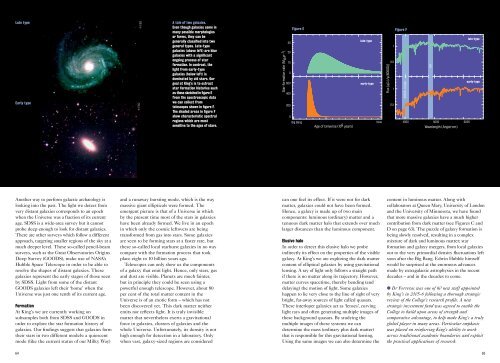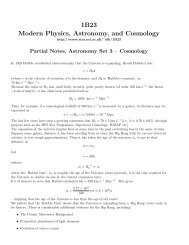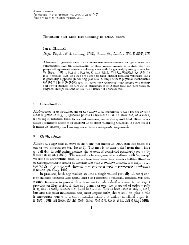Cosmic Archaeology
Cosmic Archaeology
Cosmic Archaeology
You also want an ePaper? Increase the reach of your titles
YUMPU automatically turns print PDFs into web optimized ePapers that Google loves.
Late type<br />
Early type<br />
© ESO<br />
© ESO<br />
A tale of two galaxies.<br />
Even though galaxies come in<br />
many possible morphologies<br />
or forms, they can be<br />
generally classified into two<br />
general types. Late-type<br />
galaxies (above left) are blue<br />
galaxies with a significant<br />
ongoing process of star<br />
formation. In contrast, the<br />
light from early-type<br />
galaxies (below left) is<br />
dominated by old stars. Our<br />
goal at King’s is to extract<br />
star formation histories such<br />
as those sketched in figure E<br />
from the spectroscopic data<br />
we can collect from<br />
telescopes shown in figure F.<br />
The shaded areas in figure F<br />
show characteristic spectral<br />
regions which are most<br />
sensitive to the ages of stars.<br />
Star formation rate (M • yr- 1 )<br />
Figure E<br />
30<br />
20<br />
10<br />
0<br />
600<br />
400<br />
200<br />
0<br />
Big<br />
0<br />
Bang<br />
5 10<br />
Age of Universe (10 9 years)<br />
late-type<br />
early-type<br />
Now<br />
Flux [f(l)/f(6000Å)]<br />
1<br />
0.5<br />
1<br />
0.5<br />
Figure F<br />
4000Å–break<br />
Hß<br />
4000 5000 6000<br />
Wavelength (Angstrom)<br />
late-type<br />
early-type<br />
Another way to perform galactic archæology is<br />
looking into the past. The light we detect from<br />
very distant galaxies corresponds to an epoch<br />
when the Universe was a fraction of its current<br />
age. SDSS is a wide-area survey but it cannot<br />
probe deep enough to look for distant galaxies.<br />
There are other surveys which follow a different<br />
approach, targeting smaller regions of the sky at a<br />
much deeper level. These so-called pencil-beam<br />
surveys, such as the Great Observatories Origins<br />
Deep Survey (GOODS), make use of NASA’s<br />
Hubble Space Telescope in order to be able to<br />
resolve the shapes of distant galaxies. These<br />
galaxies represent the early stages of those seen<br />
by SDSS. Light from some of the distant<br />
GOODS galaxies left their ‘home’ when the<br />
Universe was just one tenth of its current age.<br />
Formation<br />
At King’s we are currently working on<br />
subsamples both from SDSS and GOODS in<br />
order to explore the star formation history of<br />
galaxies. Our findings suggest that galaxies form<br />
their stars in two different models: a quiescent<br />
mode (like the current status of our Milky Way)<br />
and a runaway bursting mode, which is the way<br />
massive giant ellipticals were formed. The<br />
emergent picture is that of a Universe in which<br />
by the present time most of the stars in galaxies<br />
have been already formed. We live in an epoch<br />
in which only the cosmic leftovers are being<br />
transformed from gas into stars. Some galaxies<br />
are seen to be forming stars at a faster rate, but<br />
these so-called local starburst galaxies in no way<br />
compare with the formation process that took<br />
place eight to 10 billion years ago.<br />
Telescopes can only show us the components<br />
of a galaxy that emit light. Hence, only stars, gas<br />
and dust are visible. Planets are much fainter,<br />
but in principle they could be seen using a<br />
powerful enough telescope. However, about 80<br />
per cent of the total matter content in the<br />
Universe is of an exotic form – which has not<br />
been discovered yet. This dark matter neither<br />
emits nor reflects light. It is truly invisible<br />
matter that nevertheless exerts a gravitational<br />
force in galaxies, clusters of galaxies and the<br />
whole Universe. Unfortunately, its density is not<br />
high enough for detection in a laboratory. Only<br />
when vast, galaxy-sized regions are considered<br />
can one feel its effect. If it were not for dark<br />
matter, galaxies could not have been formed.<br />
Hence, a galaxy is made up of two main<br />
components: luminous (ordinary) matter and a<br />
tenuous dark matter halo that extends over much<br />
larger distances than the luminous component.<br />
Elusive halo<br />
In order to detect this elusive halo we probe<br />
indirectly its effect on the properties of the visible<br />
galaxy. At King’s we are exploring the dark matter<br />
content of elliptical galaxies by using gravitational<br />
lensing. A ray of light only follows a straight path<br />
if there is no matter along its trajectory. However,<br />
matter curves spacetime, thereby bending (and<br />
delaying) the motion of light. Some galaxies<br />
happen to lie very close to the line of sight of very<br />
bright, far-away sources of light called quasars.<br />
These interloper galaxies act as ‘lenses’, curving<br />
light rays and often generating multiple images of<br />
these background quasars. By studying the<br />
multiple images of these systems we can<br />
determine the mass (ordinary plus dark matter)<br />
that is responsible for this gravitational lensing.<br />
Using the same images we can also determine the<br />
content in luminous matter. Along with<br />
collaborators at Queen Mary, University of London<br />
and the University of Minnesota, we have found<br />
that more massive galaxies have a much higher<br />
contribution from dark matter (see Figures C and<br />
D on page 63). The puzzle of galaxy formation is<br />
being slowly resolved, resulting in a complex<br />
mixture of dark and luminous matter; star<br />
formation and galaxy mergers, from local galaxies<br />
out to the very primordial density fluctuations left<br />
soon after the Big Bang. Edwin Hubble himself<br />
would be surprised at the enormous advances<br />
made by extragalactic astrophysics in the recent<br />
decades – and in the decades to come.<br />
l Dr Ferreras was one of 60 new staff appointed<br />
by King’s in 2005-6 following a thorough strategic<br />
review of the College’s research profile. A new<br />
strategic investment fund was agreed to enable the<br />
College to build upon areas of strength and<br />
comparative advantage, to help make King’s a truly<br />
global player in many areas. Particular emphasis<br />
was placed on reinforcing King’s ability to work<br />
across traditional academic boundaries and exploit<br />
the practical applications of research.<br />
64 65











